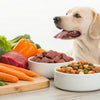Is Dehydrated Dog Food Raw? Exploring the Best Option for Your Canine Companion
- Houndsy
Table of Contents
- Introduction
- Understanding Dehydrated Dog Food
- Is Dehydrated Dog Food Considered Raw?
- The Benefits of Dehydrated Dog Food
- The Drawbacks of Dehydrated Dog Food
- Comparing Dehydrated Dog Food to Other Options
- Enhancing the Feeding Ritual with the Houndsy Kibble Dispenser
- Conclusion
Introduction
Did you know that a significant percentage of dog owners are now opting for alternative diets for their pets, with many questioning the benefits of feeding their dogs raw or dehydrated forms of food? As pet parents, we all want the best for our furry friends, especially when it comes to their diet. But with so many options available, it's easy to feel overwhelmed. So, is dehydrated dog food raw? The answer might surprise you.
In recent years, the trend toward natural and raw diets for dogs has surged, driven by a growing awareness of the nutritional benefits associated with a less processed approach to pet food. Dehydrated dog food, often seen as a convenient alternative to raw feeding, retains many of the benefits without some of the associated risks. In this article, we’ll delve into the differences between raw and dehydrated dog food, investigate whether dehydrated foods can be classified as raw, and explore the ways in which the Houndsy Kibble Dispenser can enhance your feeding routine.
By the end of this post, you will have a thorough understanding of dehydrated dog food, its benefits, and how it compares to traditional raw diets, allowing you to make informed choices that will positively impact your dog’s health and well-being.
Understanding Dehydrated Dog Food
What is Dehydrated Dog Food?
Dehydrated dog food is made by removing moisture from raw ingredients through a gentle heating process. Unlike traditional kibble, which is cooked at high temperatures that strip away nutrients, dehydration maintains a significant portion of the food's natural vitamins and enzymes. The removal of moisture also helps to prevent bacterial growth, making dehydrated food a safer option while preserving the food's nutritional integrity.
Dehydrated food typically contains a combination of meats, vegetables, and grains, creating a balanced diet for our canine companions. Because dehydrated foods are lightweight, they are ideal for storage and travel, and they can last much longer than fresh or frozen options.
How is Dehydrated Food Made?
The process of creating dehydrated dog food involves heating the ingredients at a controlled temperature to remove moisture without cooking them. This method allows the food to retain more nutrients than standard kibble. Once prepared, dehydrated food requires rehydration—simply add water, wait a few minutes, and it's ready to serve. This makes it convenient for busy dog owners who still want to provide a high-quality diet for their pets.
Nutritional Benefits of Dehydrated Dog Food
-
Preservation of Nutrients: Dehydration helps maintain the integrity of vitamins, minerals, and enzymes that can be lost during high-temperature cooking processes.
-
Improved Digestibility: The slow cooking process during dehydration allows the food to break down more easily in your dog's digestive system, which can be particularly beneficial for older dogs or those with sensitive stomachs.
-
Safety: Dehydrated dog food removes much of the moisture, which diminishes the risk of bacteria such as Salmonella or E. coli found in raw meats, providing a safer option for feeding.
-
Convenience: With a longer shelf life than fresh foods and easy preparation steps, dehydrated foods can fit seamlessly into pet owners' busy lives.
Is Dehydrated Dog Food Considered Raw?
To answer the question, "is dehydrated dog food raw?" we need to look at the definitions and processes involved in both raw and dehydrated diets.
Raw Dog Food Defined
Raw dog food typically includes uncooked, unprocessed meats, bones, fruits, and vegetables. Proponents of raw feeding argue that it mimics the natural diet of dogs' wild ancestors and therefore optimizes their health. Raw food can come in various forms, including whole prey, ground meat, and raw meaty bones, and often requires careful handling to avoid contamination.
Comparing Dehydrated and Raw Dog Food
While dehydrated dog food can start with raw ingredients, the process of dehydration entails a level of heat that slightly cooks the food. This means that while it still retains many nutrients and maintains a somewhat raw state, it is not immaculate raw food in the same sense as a fresh, uncooked diet.
The main differences can be summarized as follows:
- Moisture Content: Dehydrated dog food is low in moisture, while raw dog food consists of fresh ingredients with high water content.
- Cooking Process: Dehydrated food undergoes a gentle drying process that uses heat, whereas raw food is typically served in its natural, uncooked state.
- Texture and Preparation: Dehydrated foods need to be rehydrated prior to serving, while raw foods can be fed as is.
Given these distinctions, while dehydrated dog food may not be a "raw" food in the most stringent sense, it is an excellent alternative that balances convenience, safety, and nutritional benefits.
The Benefits of Dehydrated Dog Food
1. Nutritional Value
One of the most significant advantages of dehydrated dog food is that it retains more nutrients than highly processed kibble. A high-quality dehydrated dog food will contain whole ingredients that are rich in nutrients, providing your pup with the vitamins and minerals they need for optimal health.
2. Convenience and Storage
Unlike raw dog food that must be kept frozen or refrigerated and requires careful preparation, dehydrated dog food is easy to store for extended periods. The lightweight nature of dehydrated food also makes it great for travel. Just pack it in your bag, and when it’s mealtime, add water!
3. Increased Hydration
Dehydrated food requires water to prepare, which helps ensure that your pup stays hydrated. Because dogs often do not drink enough water, having a feeding option that requires rehydration can be beneficial for their overall health.
4. Variety of Ingredients
Many premium brands of dehydrated dog food source high-quality meats and organic vegetables, offering a balanced diet without any fillers or artificial ingredients. This variety allows pet owners to tailor their dog's diet to their specific needs, preferences, or sensitivities.
5. Great for Sensitive Stomachs
Many dogs with picky appetites or sensitive stomachs respond better to whole food diets that include dehydrated offerings. The more gentle processing retains their natural flavors, appealing to dogs who may reject kibble.
The Drawbacks of Dehydrated Dog Food
While dehydrated dog food is packed with advantages, it does come with some considerations:
1. Rehydration Time
Dehydrated food must be rehydrated before feeding, which can take 5-10 minutes. While this is relatively quick, it may not be as convenient as simply pouring kibble into a dish.
2. Cost
High-quality dehydrated dog food can be more expensive than traditional kibble. Owners should be prepared for higher price points, as the quality of the ingredients and the production process contribute to costs.
3. Portion Control
It's important to measure portions carefully when feeding dehydrated dog food since it expands when hydrated. This can lead to confusion if transitioning from standard kibble or raw feeding.
Comparing Dehydrated Dog Food to Other Options
Dehydrated vs. Kibble
Kibble is often favored for its convenience, but it may lack the nutritional value found in dehydrated dog food. Kibble is high in carbohydrates and may contain low-quality fillers. In contrast, dehydrated dog food focuses more on whole ingredients.
Dehydrated vs. Raw
As we’ve established, dehydrated dog food uses heat to preserve its ingredients, while raw dog food retains its moisture content and doesn't undergo any cooking process. However, dehydrated foods are easier to store and use in various feeding practices without the same sanitation concerns as raw diets.
Dehydrated vs. Freeze-Dried
Both dehydrated and freeze-dried dog foods retain several nutrients better than cooked kibble. Freeze-dried dog food undergoes a more intricate process that keeps the proteins and enzymes intact without any heat exposure, but it may be pricier than dehydrated options. Both require rehydration, yet freeze-dried food can typically retain flavor and texture better.
Enhancing the Feeding Ritual with the Houndsy Kibble Dispenser
At Houndsy, we believe that feeding your dog shouldn’t just be an obligation; it can be a beautiful and enjoyable ritual. Our flagship product, the Houndsy Kibble Dispenser, revolutionizes the dog-feeding experience, combining elegance with functionality. Here are several reasons why incorporating the Houndsy Kibble Dispenser into your pet care routine can elevate your experience:
-
Convenience and Ergonomic Design: With our convenient crank at standing height, there’s no need to bend down during meal times. This feature not only minimizes strain on your back but also makes the entire feeding process smoother.
-
Precise Portion Control: The Houndsy Kibble Dispenser allows you to serve consistent, perfect portions every time. You’ll never worry about overfeeding or underfeeding, allowing you to control your dog's diet effectively.
-
Aesthetic Appeal: We marry mid-century modern design with practical pet care. The Houndsy Kibble Dispenser isn’t just a feeding tool; it’s a stylish addition to your living space that complements your home decor.
-
Large Storage Capacity: Our dispenser can hold between 25 to 30 pounds of food, reducing the need for frequent refills and allowing you to purchase high-quality foods in bulk.
If you’re interested in upgrading your dog-feeding routine, we encourage you to check out the Houndsy Kibble Dispenser. By investing in this elegantly designed dispenser, you’re not only streamlining the feeding process but also enhancing the nutrition and care your dog receives.
Conclusion
Choosing the right diet for our dogs is a crucial part of being responsible pet owners. Dehydrated dog food offers many of the benefits of a raw diet without some of the risks, making it an appealing option for those looking for convenience and nutrition. While not raw in the purest sense, dehydrated options still provide valuable nutrients and ease of preparation.
Ultimately, the choice between dehydrated, raw, or other forms of dog food depends on your pet’s specific needs and your lifestyle as a pet parent. As you explore these options, remember that integrating tools like the Houndsy Kibble Dispenser can further refine and enhance your pet care routine, making your feeding ritual a more enjoyable experience.
FAQ
1. Is dehydrated dog food safe for my dog? Yes, dehydrated dog food is generally safe for dogs and offers a nutritious alternative to traditional diets. Just ensure you choose high-quality brands free from fillers and preservatives.
2. How do I prepare dehydrated dog food? Simply combine the recommended portion of dehydrated food with warm water, wait a few minutes for it to hydrate, and serve.
3. Can dehydrated dog food help with my dog’s picky eating habits? Many dogs find the flavor and texture of rehydrated dehydrated food appealing, which can help encourage even picky eaters to enjoy their meals.
4. How does dehydrated food compare with raw food? While dehydrated food offers a balance of nutrition with convenience, raw food is typically unprocessed and should be carefully handled to avoid health risks. Both diets can be beneficial, depending on your dog’s needs.
5. Can I use the Houndsy Kibble Dispenser for dehydrated food? Yes, the Houndsy Kibble Dispenser is designed for dry kibble but can also be suitable for storing dehydrated food as long as it’s kept dry and free of moisture.
By keeping these insights in mind, you’re well on your way to making informed choices that contribute to your dog’s health and happiness!












